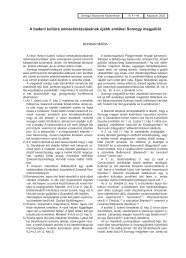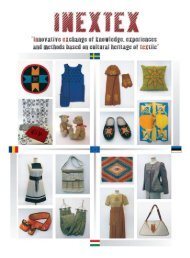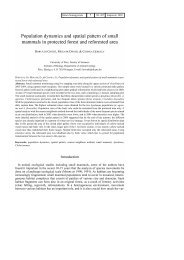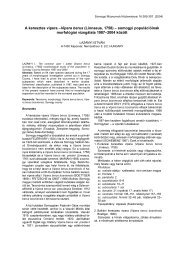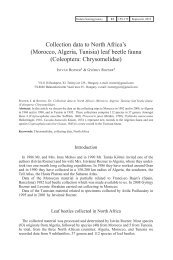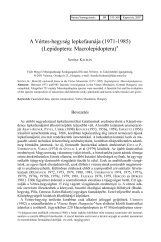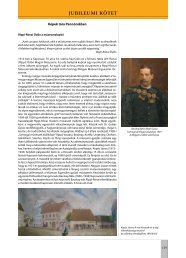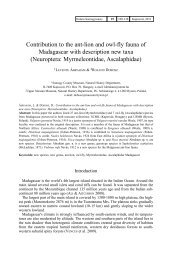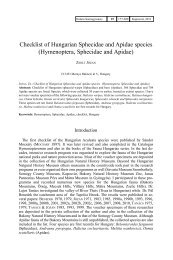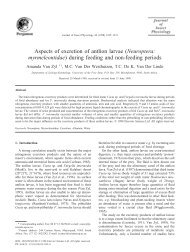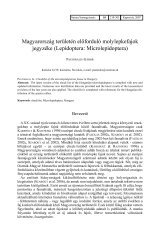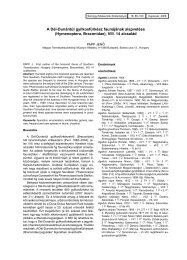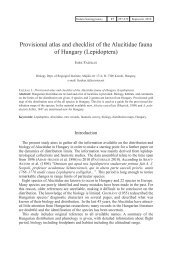Study on the Palaearctic Pristiphora species (Hymenoptera ...
Study on the Palaearctic Pristiphora species (Hymenoptera ...
Study on the Palaearctic Pristiphora species (Hymenoptera ...
You also want an ePaper? Increase the reach of your titles
YUMPU automatically turns print PDFs into web optimized ePapers that Google loves.
HARIS A.: STUDY ON THE PALAEARCTIC PRISTIPHORA SPECIES<br />
215<br />
lateral spots <strong>on</strong> tergites 1-2 red. Fig. 219. Thorax, head and antenna black, <strong>on</strong>ly labrum<br />
white. Legs red, coxae, hind femora entirely and first and middle femora more or less<br />
black. Sawsheath slightly notched. 5.1-5.9 mm.......................P. fulvobalteata Takeuchi<br />
Known <strong>on</strong>ly from Japan (H<strong>on</strong>shu).<br />
5. Abdomen yellow (in this case, apex of hind femora always yellow!), or yellow with<br />
black apex. First tergite entirely yellow or with black spot or entirely black.................6.<br />
- Abdomen above always black, ventrally, sometimes even apically, whitish yellow, in<br />
<strong>on</strong>e <strong>species</strong> (P. albomarginata Lindqvist) sternites pale brown (not whitish). Sometimes<br />
<strong>on</strong>ly <strong>the</strong> sternites with light spots. In light forms, <strong>the</strong> black pattern may restrict for <strong>the</strong><br />
first abdominal tergites in P. pallidiventris Fallén, in this case, <strong>the</strong> apex of hind femur<br />
also black. (See also P. camtschaticalis Enslin in <strong>the</strong> notes)..........................................11.<br />
6. Abdomen yellow. Only first tergite may darkened. Head, antenna and thorax black.<br />
Pr<strong>on</strong>otum and tegula yellow. Legs dominantly yellow. Apex of hind femur never black !<br />
If it black or darkened see P. pallidiventris Fallén (light colour form). Apical part of sawsheath<br />
black. Hind tarsi and apical ring of hind tibia infuscate.......................................7.<br />
- First tergite and apex of abdomen black, o<strong>the</strong>rwise yellow or abdominal tergites with<br />
very pale/white middle band <strong>on</strong> 2-4 segments.................................................................8.<br />
7. Clypeus and supraclypeal area black. Middle tarsus infuscate. First abdominal tergite<br />
(propodeum) basally brownish black or black. Fig. 184. 4.8 mm...........P. beaum<strong>on</strong>ti Zirngiebl<br />
Spain and North Africa: Algeria and Morocco.<br />
- Clypeus and <strong>the</strong> supraclypeal triangular area yellow. Middle tarsus yellow. First<br />
abdominal tergite (propodeum) yellow. Fig. 198. 5.0 mm.<br />
................................P. atlantica Malaise (syn. P. pallidiventris ssp. atlantica Lacourt)<br />
Spain, Portugal, Azores and Madeira.<br />
8. Hind femur entirely yellow, first tergite and abdominal apex (2 or 3 apical segments)<br />
black.................................................................................................................................9.<br />
- Black, pale yellow: labrum, clypeus, broad angles of pr<strong>on</strong>otum, tegula, abdominal<br />
segments 2-4. Legs black, apices of coxae, trochanters, four anterior tibiae and <strong>the</strong>ir<br />
tarsi, posterior tibia except <strong>the</strong>ir apex and basal part of posterior basitarsus pale yellow.<br />
Stigma and venati<strong>on</strong> dark brown. 5.0 mm.................................P. albobalteata Takeuchi<br />
Known <strong>on</strong>ly from Japan (H<strong>on</strong>shu).<br />
9. Hind basitarsus black; head with sparse hairwarts; tegula in male yellow. Fig. 212.<br />
6.5 mm.........................................................................................P. nigrotarsalina Wei<br />
Known from China: Guangxi.<br />
- Hind basitarsus yellow..............................................................................................10.<br />
10. Hind tarsus entirely yellow; tangium (basal untoo<strong>the</strong>d part of saw) less than 4 times<br />
as l<strong>on</strong>g as wide, apical process oblique at an angle about 45 degree. Inner hind tibial spur<br />
l<strong>on</strong>g, about as l<strong>on</strong>g as half of <strong>the</strong> hind basitarsus. Stigma darker than costa. 6.0 mm. Fig.<br />
211................................................................................................P. melanopygialia Wei<br />
Known from China: Henan.<br />
- Hind tarsomeres 2-5 black; tangium more than 4 times as l<strong>on</strong>g as broad, and apical<br />
process oblique at an angle about 35 degree. Inner hind tibial spur l<strong>on</strong>g, about as l<strong>on</strong>g<br />
as half of <strong>the</strong> hind basitarsus. Stigma <strong>on</strong>ly slighty darker than costa. 7.0 mm. Fig. 207.<br />
.....................................................................................................P. ch<strong>on</strong>ganica Wei<br />
Known from China: Fujian.<br />
11. Sawsheath in Fig. 33. [Variously coloured. Legs extensively yellowish white. Hind<br />
tibial apex and hind tarsus darkened. Hind femur sometimes with brown l<strong>on</strong>gitudinal<br />
strips. Specimens with extensively brown hind femur frequently occur. Tegula, most of<br />
<strong>the</strong> pr<strong>on</strong>otum, labrum, clypeus, last abdominal tergite whitish. Abdominal sternites variously<br />
coloured, sometimes <strong>on</strong>ly <strong>the</strong> apical sternit, sometimes most of <strong>the</strong> sternites light



